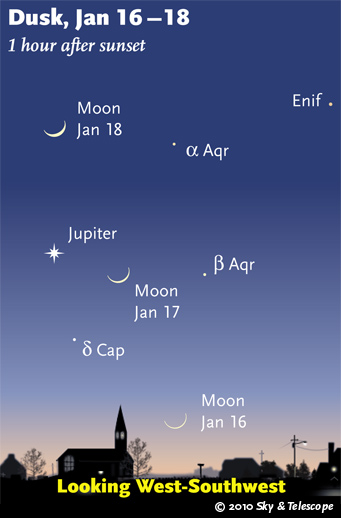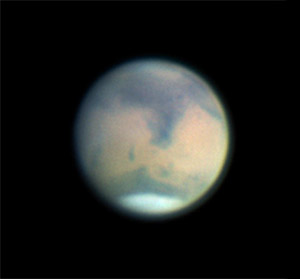Some daily events in the changing sky for January 15 – 23.
Friday, January 15

With Jupiter lighting the way, watch for this month's return of the waxing crescent Moon.
Sky & Telescope diagram
Saturday, January 16
Sunday, January 17
Monday, January 18
Tuesday, January 19
Wednesday, January 20
Thursday, January 21
Friday, January 22
Saturday, January 23
Want to become a better amateur astronomer? Learn your way around the constellations. They're the key to locating everything fainter and deeper to hunt with binoculars or a telescope. For an easy-to-use constellation guide covering the whole evening sky, use the big monthly map in the center of each issue of Sky & Telescope, the essential magazine of astronomy. Or download our free Getting Started in Astronomy booklet (which only has bimonthly maps).
Sky Atlas 2000.0 (the color Deluxe Edition is shown here) plots 81,312 stars to magnitude 8.5. That includes most of the stars that you can see in a good finderscope, and typically one or two stars that will fall within a 50× telescope's field of view wherever you point. About 2,700 deep-sky objects to hunt are plotted among the stars.
Alan MacRobert
Once you get a telescope, to put it to good use you'll need a detailed, large-scale sky atlas (set of charts; the standards are Sky Atlas 2000.0 or the smaller Pocket Sky Atlas) and good deep-sky guidebooks (such as Sky Atlas 2000.0 Companion by Strong and Sinnott, the more detailed and descriptive Night Sky Observer's Guide by Kepple and Sanner, or the classic Burnham's Celestial Handbook). Read how to use them effectively.
Can a computerized telescope take their place? I don't think so — not for beginners, anyway (and especially not on mounts that are less than top-quality mechanically). As Terence Dickinson and Alan Dyer say in their Backyard Astronomer's Guide, "A full appreciation of the universe cannot come without developing the skills to find things in the sky and understanding how the sky works. This knowledge comes only by spending time under the stars with star maps in hand and a curious mind." Without these, "the sky never becomes a friendly place."
More beginners' tips: "How to Start Right in Astronomy".
This Week's Planet Roundup
Mercury is having a good morning apparition. Look for it low in the southeast about an hour before your local sunrise time. Don't confuse it with Antares roughly 30° to its upper right, or Altair a similar distance to its left.
Venus is hidden behind the glare of the Sun.
Mars, shining fiery bright at magnitude –1.2, rises in the east-northeast in twilight and shines high in the east by late evening. It's at the border of Leo and Cancer, with dimmer Regulus about a fist-width below it during evening. Mars is highest due south around 1 a.m.

Dark Syrtis Major was almost dead center on Mars when Ian Sharp in Britain took this image at 0:54 UT January 4, 2010. The North Polar Cap is huge and obvious. The slightly bright region on the southern limb (top) is the dusty Hellas basin. The central meridian longitude was 280°. South is up.
Stacked-video images like this will generally show much more detail on a planet than can be seen by eye even through the same telescope.
In a telescope Mars is 14 arcseconds wide, essentially as large as it will become this year. The big, white north polar cap is in fine view, bordered by a very wide dark zone. Identify other surface features using the Mars map and observing guide in the December Sky & Telescope, page 57. Mars is closest to Earth on January 27th, when it will be 14.1 arcseconds wide, and it's at opposition on the 29th.
Jupiter (magnitude –2.1, at the Capricornus-Aquarius border) shines low in the southwest in twilight and sets fairly soon after dark.
Saturn (magnitude +0.8, in Virgo) rises in the east around 10 or 11 p.m. and stands highest in the south around 4 a.m. In earliest dawn, notice the huge, horizontal line of Pollux, Mars, Regulus, Saturn, and Spica running all the way from west-northwest to south. In a telescope Saturn's rings are tilted 5° from edge-on to us, their maximum tilt until next August.
Uranus (magnitude 5.9, just south of the Circlet of Pisces) is still in view right after dark well to the upper left of Jupiter. Use our finder chart.
Neptune, lower right of Jupiter, is sinking away into the sunset.
Pluto is behind the glare of the Sun.
All descriptions that relate to your horizon or zenith — including the words up, down, right, and left — are written for the world's mid-northern latitudes. Descriptions that also depend on longitude (mainly Moon positions) are for North America. Eastern Standard Time (EST) equals Universal Time (also known as UT, UTC, World Time, or GMT) minus 5 hours.
To be sure to get the current Sky at a Glance, bookmark this URL:
http://SkyandTelescope.com/observing/ataglance?1=1
If pictures fail to load, refresh the page. If they still fail to load, change the 1 at the end of the URL to any other character and try again.
 0
0
Comments
You must be logged in to post a comment.